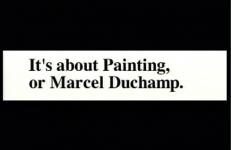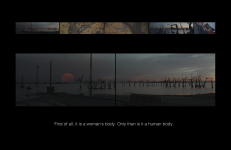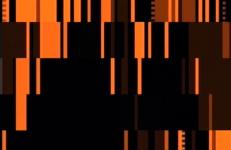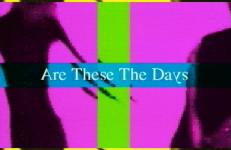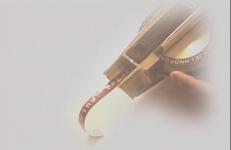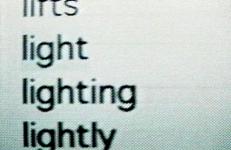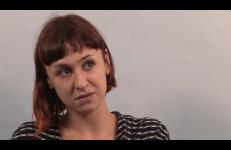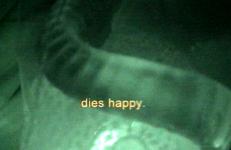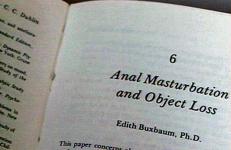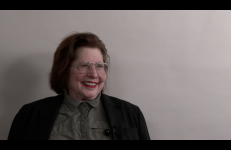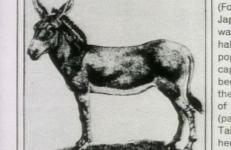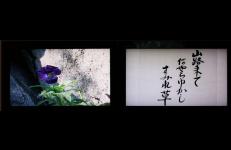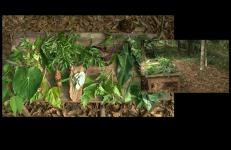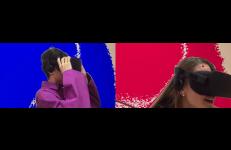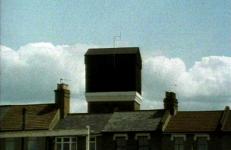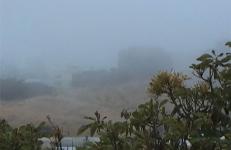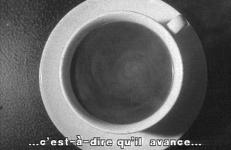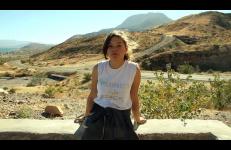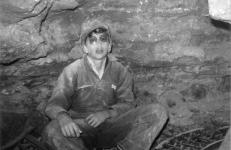2@ is part of the Pop Manifestos series, a five-video project realized in collaboration with Cokes' former students Seth Price and Damian Kulash, and originally conceived as part of a series for the conceptual band SWIPE.
Language
The sonic fabric of 2nd Person, [originally] a multi-channel video installation, is formed through an array of women’s voices orchestrated as parallel tracks in a musical composition. The speakers, all women I have intimately known at different points in my life -- my child, my mother, my best friends, students, mentors -- talk with me about aging, growing up, death, motherhood, love and loss.
3# is part of the Pop Manifestos series, a five video project realized in collaboration with Cokes' former students Seth Price and Damian Kulash, and originally conceived as part of a series for the conceptual band SWIPE.
A video poem about memory and loss. The abstraction in the meaning of words and how they become more dynamic in our consciousness.
"Ad Vice consists of a succession of colored projection surfaces with segments of text from the worlds of advertising, sport and popular culture. These projection surfaces in turn alternate with images of a rock band whose music continuously frames the whole. As regards form and content, the video looks like a commercial, an advertising spot for SWIPE country. The fast changing images, the continual music, and the starting and ending credits refer to it. The viewer is greeted with the words: welcome to SWIPE country... enjoy the sound... make contact...
"Combining the comical with the absurd, I created six funny faces to animate the images of Japanese vowels while differentiating between 'image', 'letter', and 'voice'."
— Takahiko iimura
"iimura deconstructs our coherence as he shifts between the English roman alphabet and Japanese characters, interjects spoken Japanese, and manipulates the computer images of his features. The images often take on geometrical shapes, others recall the classical images from Japanese woodcuts of Samurai warrior grimace."
— Robert West, Curator, Mint Museum of Art, Charlotte, NC
alexia is an experimental video about word-blindness and metaphor. Word-blindness is a condition that usually afflicts people who have suffered a stroke, causing them to lose the visual recognition of individual letters but perceive the entire word, or vice versa. Metaphor is here discussed in its function to reveal and obscure perception. Divided into five short sections, the video draws a pattern with the motif of the finger and the moon to ruminate on language and blindness.
Alphabetically Sorted is a scrolling list of 644 keywords downloaded from CompuServe and spoken by “Victoria: High Quality,” a speech synthesis program.
This title is only available on e-(d)entity.
In this interview, Basma Alsharif (b.1983) examines the multiple ways in which her work engages with the notion of nomadism. Beginning with a discussion of how she initially came to video through photography, Alsharif describes how this transformation of her practice required a translation of artistic sensibilities.
"I'm not going to go to the Anne Frank House—I don't think I could take it—being a tourist is bad enough—though I'm not really a tourist—I'm here working—my camera's the one on vacation—taking holiday sounds and images—it's having a nice change of pace—for me it's still the same old thing—talking and talking.
"Ever on the lookout for learning opportunities, Reinke envisions an art institute where you don’t have to make anything, and with a library full of books glued together. All the information’s there—you just don’t have to bother reading it!"
—New York Video Festival (2002)
Suzanne Anker (b. 1946) is an American visual artist and theorist. Considered a pioneer in the field of Bio Art, her work is situated at the intersection of artistic practice and biological science. Through a concern for genetics, climate change, species extinction, and toxic degradation, Anker draws focus on the “necessity for enlightened thinking about nature’s ‘tangled bank.’”
Images from magazines and color supplements accompany a spoken text taken from Herbert H. Clark’s “Word Associations and Linguistic Theory” (in New Horizons in Linguistics, ed. John Lyons,1970). By using the ambiguities inherent in the English language, Associations sets language against itself. Image and word work together and against each other to destroy and create meaning.
Split screen. On the left is a walk up a twisting, rocky trail while on the right is Kanji caligraphy describing the action, completing a Haiku by Basho.
This title is also available on Sympathetic Vibrations: The Videoworks of Paul Kos.
As an ominous voice guides us through Best Is Man’s Breath Quality, we are confronted by dense and complex images and sounds that appear and disappear before us. From primates engaging with their reflected selves to glowing jellyfish drifting through deep and dark oceans, our visual perception of the human figure is decentered, leaving only the grain of analog and digital voices recognizable to our senses.
As an ominous voice guides us through Best Is Man’s Breath Quality, we are confronted by dense and complex images and sounds that appear and disappear before us. From primates engaging with their reflected selves to glowing jellyfish drifting through deep and dark oceans, our visual perception of the human figure is decentered, leaving only the grain of analog and digital voices recognizable to our senses.
"John Smith uses humour to repeatedly subvert and frustrate potentially threatening content in an economically constructed tale of the narrator’s descent into paranoia and, ultimately, oblivion, as he is pursued, haunted, and finally destroyed by a mysterious peripatetic black tower. Throughout, both verbal and visual imagery are low key to the point of banality; shots of familiar inner city landscapes—terraces, tower-blocks and scruffy wastelands—are set against a narrative that is laconic and bathetic in the best traditions of English suburban comedy.
This is a tape which analyzes its own discourse and processes as it is being formulated. The language of Boomerang, and the relation between the description and what is being described, is not arbitrary. Language and image are being formed and revealed as they are organized.
This title is only available on Surveying the First Decade: Volume 1.
This strange, lyrical performance video diary is a millennial reflection on the impossibility to "reveal" one’s self in stormy times such as ours. The piece is also about the intricate connections between performance and everyday life; about language, identity, love, nostalgia and activism amidst the California apocalypse.
A poetic meditation on distance, Come Closer is a short and peripatetic film, casting an affective web between the locations of Lisbon, San Francisco and Brazil. Focusing on Brazilian-Algerian filmmaker Karim Aïnouz, musician Derrick Green –– the filmmaker’s brother and lead singer of Brazilian band Sepultura –– and her own work produced in Lisbon since 1992, Come Closer can be thought as a meditation on friendship and saudade.
"This video in two parts is a newcomer's portrait of Montréal, and focuses on two of my architectural obsessions: the Hydro Québec building and the Métro. I spent my first winter in Montréal in a cold, dark, first-floor apartment. I sat in the kitchen beside the electric heater, drinking coffee and watching the disk on the electric meter spin faster and faster, all the while wondering how I would manage to pay the bills. At night, I lay in bed and looked at the enormous illuminated 'Q' on the Hydro Québec building and wondered how much it cost to keep it lit every night.
In this interview, American artist, independent curator, writer, and experimental filmmaker, Vaginal Davis reflects on her initiation into the punk rock and art scenes of Los Angeles during the 1980s and 90s, her stylistic influences, and her ongoing efforts to theorize queerness and visuality. Caught between the opposing poles of Hollywood classicism and the rawness of punk, Davis defines her unapologetically gender-bending, campy, and at times aggressively critical performances as scenarios, rather than spectacles or entertainment.
“Fouteen-year-old bone collector Maxine Rose is looking for validation from her heroes, amongst them the primatologist Jane Goodall, Archbishop Desmond Tutu and the New Zealand teen pop star Lorde. Offering them a gift of language, Maxine Rose stands for the desire to be visible and understood, not unlike the desire of an artist. We are particularly impressed by the multilayered story telling structure, the freshness of the characterization, and the honest exploration of an artists` vulnerability."
“Fouteen-year-old bone collector Maxine Rose is looking for validation from her heroes, amongst them the primatologist Jane Goodall, Archbishop Desmond Tutu and the New Zealand teen pop star Lorde. Offering them a gift of language, Maxine Rose stands for the desire to be visible and understood, not unlike the desire of an artist. We are particularly impressed by the multilayered story telling structure, the freshness of the characterization, and the honest exploration of an artists` vulnerability."
The Disappointment: Or, The Force of Credulity is a documentary about the search for four lost treasures buried on a single farm in Missouri. These treasures include a Spanish explorer's gold, silver from the Civil War, mysterious stone carvings, lost texts, and a wife's attempt to heal her husband and protect herself and her children. Part personal documentary and part historical essay, The Disappointment traces the patterns of cultural forgetting etched in the landscape of the Austin Farm.




